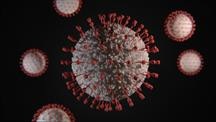China's National Health Commission announced on Friday evening that seven cases of the COVID-19 JN.1 variant have been detected domestically as of December 10. Although currently at a low prevalence, the variant, influenced by international strains and imported cases, could potentially become dominant in China. Europe has the highest proportion of cases, with rapid growth also seen in the Americas. The predominant strains in China are still EG.5 and its sub-branches.
Identified as a second-generation sub-branch of the Omicron BA.2.86 variant, JN.1 has spread to at least 40 countries/regions globally since its first detection in Luxembourg on August 25. On November 21, the World Health Organization upgraded it from a "Variant Under Monitoring" (VUM) to a "Variant of Interest" (VOI).
JN.1 has recently garnered attention, especially in Asia, where it has become the dominant strain in Singapore. The Singapore Ministry of Health reported that COVID-19 cases jumped from over 22,000 to 32,035 in the week ending December 2, with 60% of these cases being the JN.1 variant. The ministry attributes the increase to various factors, including waning immunity and increased travel and social interactions during the year-end holidays. There is no indication yet that the new variant is more transmissible or causes more severe illness. However, the U.S. Centers for Disease Control and Prevention (CDC) believes JN.1's persistence suggests it may be more transmissible or better at evading the immune system.
Amid rising infections and neighboring countries reinstating some pandemic measures, rumors circulated online in Singapore about a potential return to "circuit breaker" measures, prompting officials to debunk these as misinformation. On Monday, Singapore's Deputy Prime Minister Heng Swee Keat refuted these rumors on social media.
Other countries have responded more cautiously. According to The Straits Times, Indonesia has reinstalled temperature scanners at some border checkpoints, including Jakarta's main international airport, three entry points in Bali, and the Batam Island ferry terminal. The Indonesian Ministry of Health has urged people to postpone travel to areas with surging cases, complete vaccination, wear masks, wash hands frequently, and stay home if sick.
As of December 13, Jakarta alone reported over 300 new cases, including two deaths, with Omicron EG.5 remaining the main variant. The health ministry has issued alerts as cases have risen in 21 provinces over the past few weeks, with significant surges in four provinces on Sulawesi Island.
Indonesian President Joko Widodo confirmed an increase in cases ahead of Christmas and New Year but has not decided on mandatory mask-wearing. He has instructed the health minister to monitor the situation closely.
Malaysia also saw a near doubling of cases within a week. Authorities reported 6,796 confirmed cases for the week ending December 2, compared to 3,626 the previous week. However, the Malaysian government stated that the situation is under control and not burdening medical facilities.
In the U.S., JN.1 is showing a growing advantage. CDC data indicates that in the two weeks ending December 9, JN.1 was the second most prevalent strain in the country but the fastest-growing variant, accounting for over one-fifth of all infections.
First detected in the U.S. in September, JN.1's proportion was less than 0.1% by late October but reached 15%-29% by December 8. The CDC stated that JN.1's continued growth suggests either higher transmissibility or better immune evasion. However, there is no evidence yet that JN.1 poses a greater public health risk compared to other prevalent strains.
With the onset of the winter respiratory infection peak, COVID-19 infection rates are rising in the U.S. Although the country no longer tracks total case numbers, early indicators like test positivity rates are increasing. Last week's CDC data showed an 11.5% rise in test positivity over the previous week. NBC News analysis also indicated a 13% increase in hospitalizations and a 9% rise in ICU admissions over the past two weeks.
Experts note that with the U.S. entering the winter and respiratory virus season, COVID-19 activity is expected to rise. However, symptoms of COVID-19 are difficult to distinguish from those of other circulating viruses, including respiratory syncytial virus, influenza, and rhinoviruses, which cause common cold-like symptoms.
In Europe, there has been less focus on individual COVID-19 variants. The region's concentrated public reports on JN.1 were mostly from early last month, with sporadic warnings about its spread in Europe but lacking specific data.
The European Centre for Disease Prevention and Control's latest report on Friday indicated a surge in acute respiratory infections in Northern Hemisphere countries this winter, caused by multiple pathogens, including COVID-19, influenza, syncytial virus, and other seasonal viruses and bacteria.
Since early autumn, seasonal influenza activity and hospitalizations have been increasing in most parts of the U.S. and Canada. The U.S. also observed a slight increase in pediatric pneumonia cases caused by a range of respiratory pathogens, including Mycoplasma pneumoniae, but overall pneumonia incidence remains consistent with pre-pandemic levels.
In early November, China reported a nationwide increase in respiratory diseases, mainly affecting children, attributed to the co-circulation of multiple known pathogens, particularly Mycoplasma pneumoniae. South Korea observed an increase in Mycoplasma pneumoniae infections to levels similar to pre-pandemic seasonal patterns. Japan also reported an increase in influenza-like cases, starting earlier this season compared to previous years, including pre-pandemic seasons.






